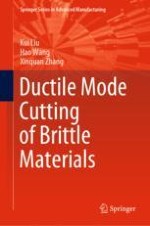2020 | OriginalPaper | Chapter
2. Ductile Mode Cutting Mechanism
Authors : Kui Liu, Hao Wang, Xinquan Zhang
Published in: Ductile Mode Cutting of Brittle Materials
Publisher: Springer Singapore
Activate our intelligent search to find suitable subject content or patents.
Select sections of text to find matching patents with Artificial Intelligence. powered by
Select sections of text to find additional relevant content using AI-assisted search. powered by
